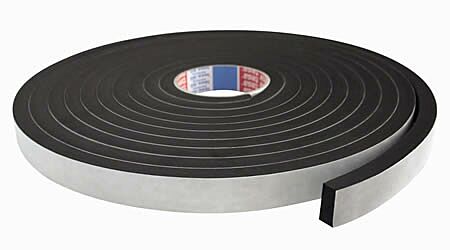The Science Behind EPDM Foam Tape: Understanding its Composition and Performance
When it comes to sealing and insulating various applications, EPDM foam tape is a reliable and versatile choice. EPDM (ethylene propylene diene monomer) foam tape is known for its exceptional performance in a wide range of industries, from construction to automotive manufacturing. In this article, we will delve into the science behind EPDM foam tape, exploring its composition and the factors that contribute to its excellent performance.
What is EPDM Foam Tape?
EPDM foam tape is a type of rubber foam tape made from EPDM material, a synthetic elastomer known for its resilience, weather resistance, and thermal stability. This foam tape is designed for sealing, insulating, and cushioning applications. It is widely used in both residential and industrial settings due to its remarkable properties.
Composition of EPDM Foam Tape
To understand the science behind EPDM foam tape, it’s essential to take a closer look at its composition. EPDM foam tape is typically made up of several key components:
1. EPDM Rubber:
The primary component of EPDM foam tape is the EPDM rubber itself. This synthetic rubber is a terpolymer of ethylene, propylene, and diene monomers, which gives it its unique characteristics. EPDM rubber is highly resistant to heat, ozone, UV rays, and weathering, making it an excellent choice for outdoor applications. Its ability to withstand temperature extremes without losing its properties is a testament to its exceptional durability.
2. Closed-Cell Structure:
The foam tape’s structure is typically closed-cell, which means that the individual cells within the foam are sealed off from each other. This structure provides excellent resistance to moisture, making EPDM foam tape ideal for sealing and insulating applications where water ingress is a concern.
3. Adhesive Backing:
EPDM foam tape often features an adhesive backing on one side, which allows for easy application. The adhesive used is specifically chosen for its compatibility with the EPDM material and its ability to create a strong, long-lasting bond with various surfaces.
Key Properties of EPDM Foam Tape
EPDM foam tape is known for its outstanding performance across a range of applications, thanks to its unique properties:
1. Weather Resistance:
One of the standout features of EPDM foam tape is its exceptional weather resistance. It can withstand exposure to extreme temperatures, UV rays, rain, and snow without deteriorating. This makes it ideal for outdoor use, such as sealing gaps in windows and doors.
2. Thermal Stability:
EPDM foam tape maintains its flexibility and resilience across a wide temperature range, from freezing cold to scorching heat. Its thermal stability ensures that it won’t become brittle in cold weather or soften in hot conditions.
3. Compression and Elasticity:
EPDM foam tape possesses excellent compression and elasticity properties. It can effectively seal gaps and joints, providing a tight and long-lasting seal while also accommodating movement and vibration.
4. Chemical Resistance:
EPDM foam tape is resistant to a variety of chemicals, oils, and solvents, making it suitable for applications where exposure to such substances is a concern.
5. Sound Damping:
This foam tape is also known for its sound-damping capabilities. It can help reduce noise transmission through doors, windows, and other gaps, enhancing the comfort of indoor spaces.
Common Applications of EPDM Foam Tape
EPDM foam tape’s versatility and impressive properties make it a popular choice in a wide range of applications, including:
1. Weather Stripping:
EPDM foam tape is frequently used as weather stripping to seal gaps around windows and doors, preventing drafts and improving energy efficiency in buildings.
2. Automotive Industry:
In the automotive sector, EPDM foam tape is used for gasketing, noise reduction, and sealing applications. It helps create airtight seals in various components, reducing noise and vibration.
3. HVAC Systems:
EPDM foam tape is employed in heating, ventilation, and air conditioning (HVAC) systems to insulate and seal ductwork and other components, enhancing system efficiency.
4. Construction:
In construction, EPDM foam tape is utilized to seal gaps and joints in building envelopes, roofs, and other structural elements, providing both insulation and weatherproofing.
5. Electrical Enclosures:
This foam tape is used to seal electrical enclosures, protecting sensitive electronic components from dust, moisture, and contaminants.
Conclusion
EPDM foam tape’s composition, which includes EPDM rubber, a closed-cell structure, and adhesive backing, along with its outstanding properties, such as weather resistance, thermal stability, and compression and elasticity, make it a versatile and reliable choice for a wide range of sealing and insulating applications. Whether in the construction industry, automotive manufacturing, or HVAC systems, EPDM foam tape plays a crucial role in enhancing the performance and longevity of various products and structures. Its enduring durability and resilience in the face of harsh environmental conditions make it a go-to solution for many professionals and DIY enthusiasts. So, the next time you’re looking for a dependable sealing and insulating material, consider the science behind EPDM foam tape and its impressive track record of performance.
